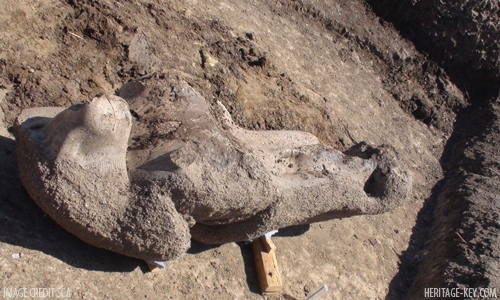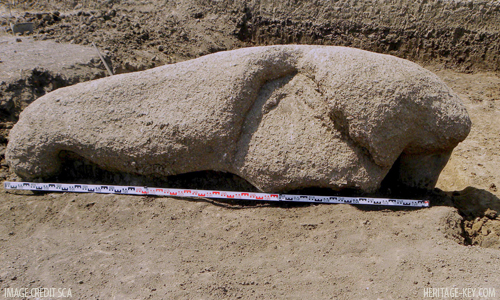
The red granite statue depicting Thoth, the ancient Egyptian deity of wisdom, is 3,5 metres tall and 140 cm wide. In a statement, Dr Zahi Hawass said that evidence found at the excavation suggests more colossi could be found here still. The first traces of these large statues were uncovered during works aiming at controlling the subterranean water level on Luxor's west bank.
The head of 2,5 metres high statue depicting Pharaoh Amenhotep III in standing position - possibly the best preserved depiction of the pharoah's face found to date - was unearthed at the King's funeral temple at Kom El-Hettan only months ago, together with a statue of the god Thoth. In 2009 two black granite statues of the pharaohs were found at the temple.
A year ago, excavations revealed a 5 metres high statue similar to the Thoth statue.
Afifi Rohayem, assistant director of the excavations, said that the site could contain an avenue of Thoth statues, who once outlined the original path leading to Amenhotep III's funeral temple.
Recent research has identified Pharaoh Amenhotep III - who ruled Egypt between 1390 BC and 1352 BC - as the most likely grandfather of Tutankhamun.
Built closer to the river than any other temple ot Thebes - right on the edge of the floodplain - after less than 200 years Amenhotep III's funerary temple had collapsed. Many of its stones were subsequently pilfered for building projects of later pharoahs.
The famous Colossi of Memnon, two 18-metres-high stone statues of Amenhotep III, are all that remains of the pharaoh's mortuary temple, once the largest religious complex an ancient Egypt.
Since 1998, the mortuary temple of Amenhotep III has been on the World Monument Fund's list of the planet's 100 most endangered monuments. Extensive excavation and restoration works at the temple site are taking place.
"I believe that in less than 20 years we will have achieved our objectives here," Dr Hourig Sourouzian said in a video interview with Heritage Key. The final stage of the works at Amenhotep III's mortuary temple will be the creation of an open-air museum.




Reader Comments
to our Newsletter